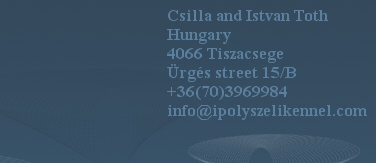 |
Standard Poodle (Caniche Grand)
General
description
Color:
white, black, brown, grey, orange fawn (apricot), red fawn. Size: 45-60 cm. Weight: 25-30 kg.
There
are 3 different variants: standrad, medium, and miniature. (description of the
medium and miniature poodles are below).
Elegant
built, free, easy and feathery moving dog with an interesting appearance. The
head is a bit tapered, it's size is balanced to the body. Eyes are brown and
hollow. Has well developed teeth, correct scissor bite. Has long, floppy ears
with rounded end. Nose is black, but maroon is also allowed by browns. The head is
carried high and proudly. The neck, without dewlap, is of oval cross section. Forequarters
are perfectly upright and parallel, well muscled with good bone. Hind legs parallel seen from behind; muscles
developed and very apparent. Feet are rather small, firm, of short oval shape.
Toes are well arched and tight fitting.
The pads are hard and thick. The nails are black in black and grey
subjects. They are black or brown in brown subjects. The body is deep, belly is
with good tuck up, topline is flat. Hair is curly or corded, needs trim.
Behaviour, temperament
Temperamental, active,
alert dog. Capable of learning and being trained. Inquisitive, devoted,
watchful. It's faithfully cotton on to the owner.
History
There are a lot
-conflicting- theories about the origin of the Poodle. It's ancestor is, beyond
all question, the Barbet, this excellent french hunting dog. Ancient roman and
greece paintings and graphics show that there were dogs trimmed like lions and
typed like Poodles in the ancient times. In the beginning of the XIV. Century,
Poodles were fancied hunting dogs in Great Britain, while they were used for
hunting in water in Germany, and Russia in the tzar times. The were used as
watchdogs in France, and some of the Poodles accompanied their owners to
campaigns in Napoleon wars. There are some written documents from the middle
ages, about Poodles entertaining townspeople by performances, taking part in
vagabondage of travelling circuses. There are some expert to think that the
“lion” trim is for showing the dog more funny in the circus.
The breed's become known as
“French Poodle” in the anglo-saxon countries, even here in Hungary was known as
“francia pudli” till 1930. After that, the german “pudel” name got abroad. The
meaning of the word is: splashing around
in water.
The breed has it's place in
the art and literature as well. There are some notes about the breed , among
others by Thomas Mann's and Beethoven's posthumous documents, but this funny
breed is seen on fine arts works as well. Tolouse Lautrec liked to draw poodles
as “properties of aristocratic women”.
It's easy to understand why
the breed's become so popular around the world. Typical of the wide popularity
that in the year 1975 there's been registered more than 200.000 Poodles in the
USA.
Utility
Poodles seem to be funny,
jumpy, playful pets, so it can be strange that Poodles are good watchdogs and
guards. But the most exciting thing in breeding that we can shape the breeds.
The smaller sized Poodles are known as companion dogs, but the standard poodle
is brave, strong and well nosed enough for watchdog work. Poodle is an ideal
sport dog. What a pity that these facts are not very known, and there are only
a few owners who utilize this fantastic intelligence, temperament, and
capability of learning and being trained, even though these are the attitudes
made Poodle to be a versatile breed: soldier, water hunter, circus dog,
watchdog and bodyguard.
Medium Poodle (Caniche
Moyen)
Size: 35-45 cm, weight 8-10 kg.
Thing worth mentioning is
the trim of the poodle's hair, what is the same by all the 3 types. The usual
form is the “lion”, what is not an accidental shape. Poodles were hunting dogs,
and their job was to find and pick the mallards (wild ducks) in the water. The
back part of the dogs was clean-shaven to help them swimming.
Later the Poodles were
trimmed the way there were some plume left to defend the joints, and the other
part of the dog was shaven. The hair was preen back from their eyes; first with
plain wire, later with colored bend. Those colored bends helped the hunters to
identify their own dogs in the grey mud.
There are some who think
the poodle's haircut ridiculous...it is for sure that these don't know anything
about the history of this unique style of trim.
The other, recently fancied
style is the so-called holland trim, what is mentioned “trim1960”, or “standard trim” in
the nomeclatories.
The heart of the matter is
that the hair is rather moderate short on the body, moare-like on the back, and
it is permanently growing to the way to sides and legs. The advantage is that
this style makes Poodles look a bit more doggy, but a disadvantage is that the
longer hair remains on the tracts where the dog's most tend to be dirty.
The holland trim is not
allowed in the USA, where the youngsters are showed whit puppy trim, and the
adults with lion or english style.
Miniature Poodle (Caniche
Nain)
Size: under35 cm. Weight:3-5 kg.
Utilization:
This size is the most
popular worldwide, kept in the house as a pet. Thos who think that the
Miniature Poodle is not a real dog at all, have not right. On the contrary:
this small dog is full of natural, lovely dog-like attitudes. They are
excellent watchdogs, good pets, companion dogs, and perfect playfellows for
children.
|
|
Magyar Agár – Hungarian Sighthound (Hungarian
Greyhound)
General
description:
Color:
brindle, party or solid, with our without white markings, black, fawn, sabled
or watermarked. Size: 65-70 cm (males), 63-69 cm(females). Weight: 25-30 kg
Ancient
hunting dog breed. Not too refined, and not too robust. The lenght of the body
is a bit bigger than the height at withers. Strong boned, musculated, slightly
built hound.
The
head is arrow headed, long. The forehead is wider than greyhound's. Teeth are
well developed, correct scissor bite needed. The nose is black. Ears are small,
soft, weared nestled up to the neck, but V shaped ears are allowed as well.
Eyes are brown, not too big, not goggled, expression is intelligent. The neck
is not to long, but elegant lined and musculated. The body is long, very
strong, deep and the brisket is a bit flat. The underline is tucked up, the
topline is flat, the loin is long and strong. The back is wide. Forelegs are
straight, strong. Upper thights are very musculated. The tail is rather long,
goes under the hock point, the end is
upsweeping. Feet are waulted, strong, toes well closed to each other.
Fur is short, but stronger than greyhound's
Temperament,
behaviour
Simple
minded, shows constraint a bit, very intelligent hound. Austere, and incredibly
wiry. The nose is rather weak, but the Agár does not need a strong nose at all,
because Magyar Agár is „hunting by eyes”, like other sighthounds. It's long,
strong legs and strong body make Magyar Agár able to follow the pray on long
distances, catch it and prostrate.
History
We
don't know a lot about the evolution of the breed. There are some theories about Magyar Agárs
arrived with the ancient hungarians by settlement in Hungary, but nowadays
these are controversial. If there were any hond typed dogs arriving with the
ancient magyars, they must have been changed a lot -crossed with orienthal
sighhound breeds during the times of turkish subjection, and later crossed to
greyhound- that the recent Magyar Agárs haven't got a lot to do with the
hypothetical ancient Agárs.
The
breed have been neglected and nearly unknown for a long time. Nobody engaged
with breeding and sublimating the Magyar Agár, and meanwhile most of the
european nations have created their own special sighthound breeds.
There
are some cynologyst to point out that because there is no tradition of Agár
racing in Hungary, the Magyar Agár in the Karpathian basin remained in the
ancient type, but has lived up local circumstances.
By
all means -and this is a big jump in Magyar Agár's history- when Agárs were
wanted for shooting a movie, there were no Magyar Agárs to act ancient Agárs in
the court of king Matthias. The Magyar Agár what seemed to be extinct, was
rediscovered by Kálmán Szigethy, leader of the film works of Gödöllő, in
Szabolcs-Szatmár-Bereg county. There he bought a bitch and two males, and
started to breed them. After that, some keen dog breeders also rediscovered the
ancient breed and the modern breeding of Magyar Agár, the shaping of the modern
Agár type has begun.
Utility
Those
who faithfully stand for the breed think that the magyar Agár is „teachable,
enduring and ambitious on the track”.
Because Magyar Agár is strong and wiry, it's keeping is simply and free
from care. Agárs are good watchdogs, and faithful, reliable companion dogs.
|
 |



